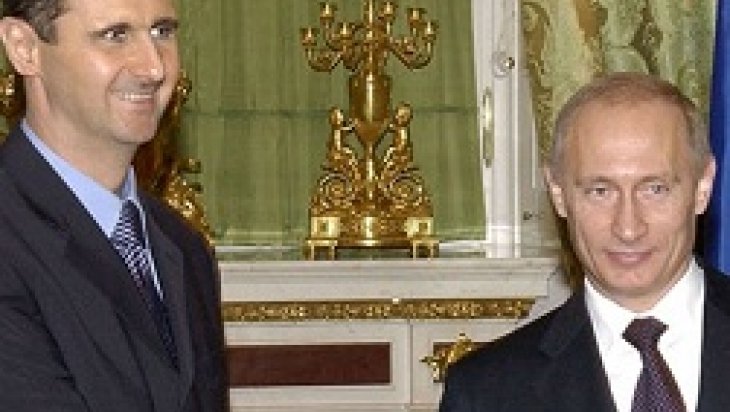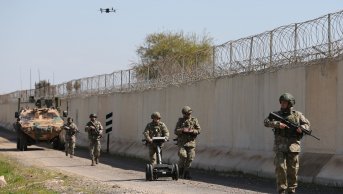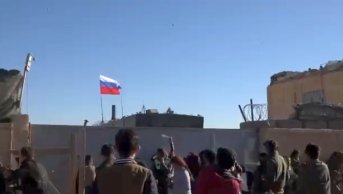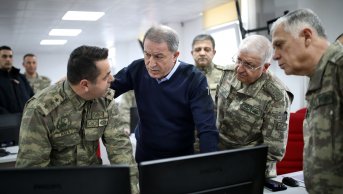Russia’s Move in Syria and Turkey

Syrian leader Bashar al-Assad indicated that “his army had difficulty in finding people to fight” in a statement he made a short time ago. In addition to this, the regime faced some mass protests even in Latakia where it has the greatest power. Protesters sought punishment for Suleiman Assad, member of Assad family after he killed an officer in Latakia following a traffic feud. Similarly, anti-government protests broke out after a Druze leader was killed in as-Swayda where there is especially a great number of pro-government Syrian Druze. People organized demonstrations around the government buildings and destroyed the statues of Hafez al-Assad. Furthermore, with the victories of the opposition in Idlib province, they reached such a position that they could directly threaten Latakia, the castle of Assad regime.
In such an environment, news have been reflected in the press showing that Russia would be a more active party in Syrian war as of the second week of September. Having supported the Assad regime since the beginning of civil war, it has been announced that Russia will set up a base and build a harbor in Latakia and it has sent a military aid package to Syria including Russian warplanes, helicopters and tanks as well as some other heavy weapons. Finally, Russia has launched air strikes in Syria in order to “support the Assad regime in its fight against terrorism” within the framework of its parliamentary approval. It has been stated that some targets in Hama, Homs and Latakia have been hit in the first stage.
Firstly, Russia’s move has an extent that will change the military balance in Syria in favor of the regime which is likely to lose power. There is no doubt that it will propose a new exit, give more support to the regime and generate its motivation. The Assad regime can control almost 30% of Syrian territory as of October 2015. Russia’s military support will contribute to the guarantee of regime control and the elimination of threats in these regions where population density is also relatively high. Concerning the region where Russia set up its base, it can be expected from Russia to prevent the upcoming threats in the cities of Latakia and Idlib, where it has been under a lot of pressure. Another contribution of Russia’s move to the regime and its supporters is that it will lower the possibility of an intra regime conflict. The regime will mobilize in order to overcome depression in the last period and continue the war.
Despite all this, Russia’s contribution will not probably make a change that will allow the regime to take back the regions under the control of the opposition or the ISIS. The ISIS has extended its territory in Syria since the beginning of the anti-ISIS US coalition including more than 60 countries. Similarly, Russian air strikes can also weaken the military capacity of the ISIS and Syrian opposition, cause them to tactically retreat, depressurize the regime controlled areas and help the regime gain lands partially. However, beyond this, it is not possible that the actors in question will be pushed out or the regime will go back to northern and eastern regions where it has hardly any presence. There are a few reasons for this. The first one is that the opposition has recorded serious progress about organization, experience, military capacity and tactics in the course of time. There are now larger military structures which can take joint actions and concentrate their force at certain centers instead of small troops which control restricted areas. It is even possible to define certain part of armed opposition groups as small armies. The second reason is that these large groups have recently had successful experience about taking joint actions. In contrast to the statements of the regime and its opposition and to the general perception of world public opinion, the opposition includes Syrians rather than foreign fighters (Certain part of the ISIS and al-Nusra is excluded). That is why these structures fight in order to protect their own lands and overturn the regime instead of a religious motivation. This increases the capacity of concerning groups to continue the war and pay the price. Nevertheless, Russia is in financial difficulties both due to the sanctions and the low oil prices. Taking this into account, we are not sure how long Russia will continue a fight that is not vital for itself. The second one has been witnessed in its fight against the ISIS in Iraq and Syria where it wasn’t an efficient ally and there was a low possibility of victory only with air support. The partial success of YPG, the militia force of Kurds, in Syria with the support of the USA can be given as example but this was an operation carried out with intense air support that had a very limited target. It doesn’t seem possible for the regime which is already on defense to be the victory in all Syrian fields by attacking with air support.
Russia’s move is efficient for the Assad regime but it is also an ace in the hole. The regime became increasingly more dependent on external support. Although Syrian regime was grateful to Iran and Hezbollah for their support, it was concerned that Iran slowly took the control of the country. This step will be relieving for Syria since it will balance Iran’s influence in the country. However, this shouldn’t directly mean that there will be a competition between Iran and Russia. On the contrary, Iran also worried to what extent it would support the regime by itself. Russia’s support will motivate Iran more and relieve its burden. Nevertheless, the regime and its supporters will have no ace in the hole unless Russia’s move leads to the retreat of the opposition, far from allowing the regime to survive.
All external actors involved in Syrian civil war defend that a military solution is not possible and a political solution should be found to the problem. Another point on which everyone agrees is the protection of Syria’s territorial integrity. However, the policies followed in practice are the exact opposite. Syria leads to disintegrated Syria which will be controlled, even if de facto, by organizations of different social circles. This results from the attitude of external actors as well as internal dynamics. From this point of view, every external actor tries to create a zone of influence within the disintegrated structure of Syria even if they all mention political solution and territorial integrity. Russia’s step will actually accelerate the disintegration process of the country and ensure a permanent regime under Russia’s control. This may disappoint the opposition in terms of the complete overturn of the Assad regime and the takeover of regime controlled areas and will pave the way for a political solution in disintegrated Syria.
Russia’s military support is a step towards the protection of its long-term interests in the Middle East and Syria on the pretext of “fight against terrorism”. In this respect, it can be foreseen that Russia’s increasing military presence will not be limited to Syrian civil war. Russia will have the chance to have a permanent military base in East Mediterranean in the long term by making use of the opportunities such as the needs of the regime and the power vacuum that the USA caused in the region. Therefore, Russia may have taken the first step to create a zone under its influence in disintegrating Syria. Even though Russia hasn’t arrived in the region for this reason, the course of events may push it to this point because Russia has risked its credibility, reputation and deterrence of its foreign policy by directly stepping into Syrian civil war. Russia will now fight not only to protect the Assad regime but also these elements. This will gradually make it an integral part of the civil war. Independently from the economic, political and safety related consequences in Russia, it is highly probable that there will be a region in Syria under Russia’s protection.
One of the biggest expectations of Russia is to fight Caucasian and Middle eastern fighters that constitute a risk to its own internal security outside its borders. “Imam Bukhari Battalion” which includes Uzbek fighters and “Jaish al-Muhajireen wal-Ansar (Army of Emigrants and Supporters)” which includes Caucasian fighters are among these. Certain part of Jaish al-Muhajireen wal-Ansar fights for the ISIS while another part is found in the lines of al-Nusra front associated with Caucasian Emirates which fights Russia. Russia will endeavor to settle accounts with these groups that pose a risk to its own security outside its borders by increasing its military presence in Syria. Putin has stated that “they cannot wait for Russia’s turn”, which should be considered in this context. One of the greatest risks for Russia is that terrorist actions may take place in its own country. Russia has increased the number of fronts against itself by targeting each group that has joined armed struggle against the Assad regime. That is why it may come under attack even in Syria.
Russia collects all armed groups fighting the Assad regime under the definition of “terrorists in Syria”. As far as Turkey is concerned, the ISIS and al-Nusra front are considered as terrorist organizations while other armed forces that fight the regime are seen as legitimate forces and more importantly, they are supported by Turkey. Therefore, Russia will hit Turkey’s allies in the area by hitting the armed groups except for the ISIS and al-Nusra in Latakia, Aleppo, Idlib, Hama and Homs. This will cause these two countries to come face to face in Syria. Russia’s support to the regime will have a deterrent effect on the other front in some ways. However, it will increase the coordination and cooperation between the internal anti-regime actors and lead the external factors to give more support.
Putin indicated that only Assad’s army and Kurds literally fight the ISIS in his statement in the UN General Assembly. This statement is a sign of Russia’s intervention in the civil war in favor of the regime and Kurds at the same time. This means that the regime and PYD/YPG that Turkey sees as terrorist organizations have been taken under the protection of Russia. However, Turkey sees both of these actors as a threat to its national security. Turkey’s step against PYD or Russia’s arms aid to PYD in Syria will pit Turkey against Russia.
Another problem for Turkey may arise in the context of safety zone that it plans to establish between Azaz district and Jarabulus. The military base that Russia plans to set up in Latakia is militarily in spitting distance from the safety zone that Turkey wants to establish. Above all, establishment of a safety zone is a military operation. Air strikes will be organized for this and land support will be provided when necessary. Highest authority of Russia announced that they opposed the establishment of a safety zone. Therefore, Turkey will have to take into consideration Russia’s nearby military presence in case of an air operation in order to establish a safety zone. This may militarily pit Turkey against Russia, which will be a deterrent factor for Turkey. The first developments which support this view took place at the beginning of October. It was indicated that a Russian warplane violated Turkish airspace on the 3rd October and it was reported that two MIG-29 aircrafts harassed Turkish F-16s on the 4th October. This shows that Russia and Turkey have a risk of engaging in close combat beyond the political tension about Syria. The parties will abstain from such a possibility. Russia’s presence will be a deterrent factor for Turkey to a certain extent. Turkey will have to consider Russian factor while taking any kind of military step from now on. However, the consequences of the competition depend on geography and how vitally actors will evaluate the problem rather than their military capacity.










